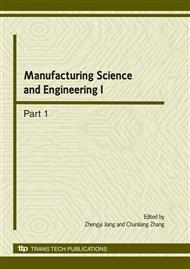p.4036
p.4042
p.4046
p.4050
p.4057
p.4061
p.4066
p.4071
p.4075
Modeling and Analysis of NC Compliant Abrade Polishing for Surface of Revolution
Abstract:
In this paper, a compliant tool was designed for abrade polishing parts with surface of revolution on general NC lathe. The tool can adapt itself automatically to the part’s surface. A magnetorheological torque servo driver (MRT) was developed to control independently the polishing force between the tool and the surface which determines the contact pressure and affects the polishing quality. The models of polishing force and contact pressure were established based on Hertz theory. The model of tool head posture was deduced. The impact of tool head posture and position on contact pressure was analyzed. The experiment results verified the validity of the compliant tool and models.
Info:
Periodical:
Pages:
4057-4060
Citation:
Online since:
March 2010
Authors:
Keywords:
Price:
Сopyright:
© 2010 Trans Tech Publications Ltd. All Rights Reserved
Share:
Citation:


